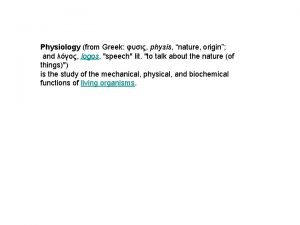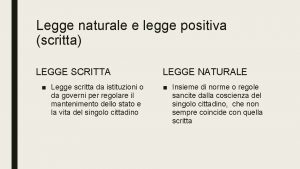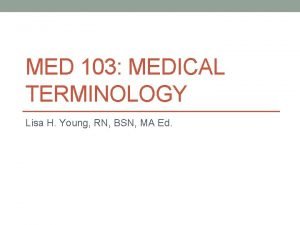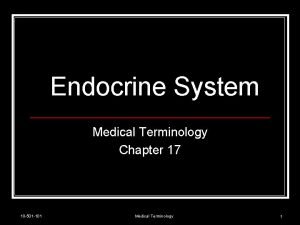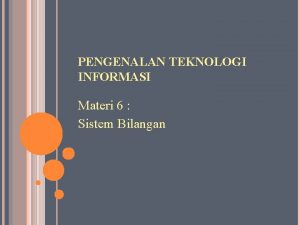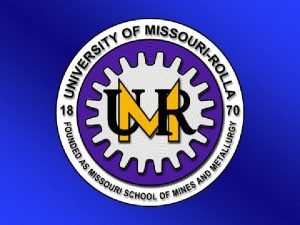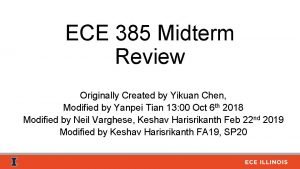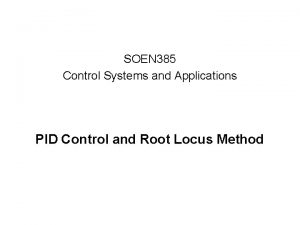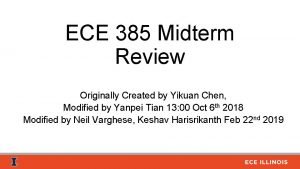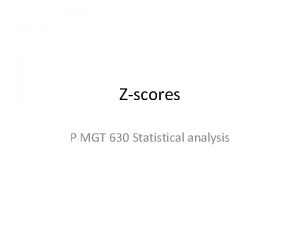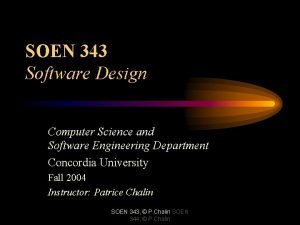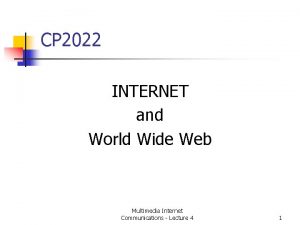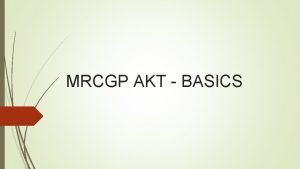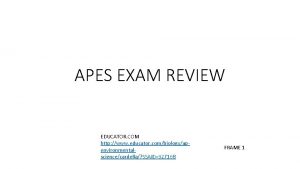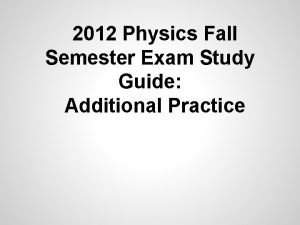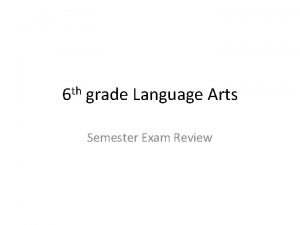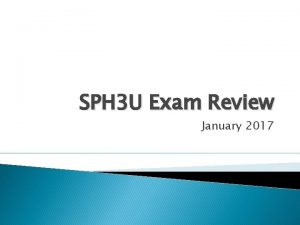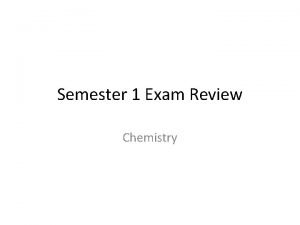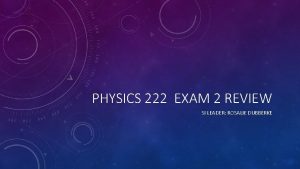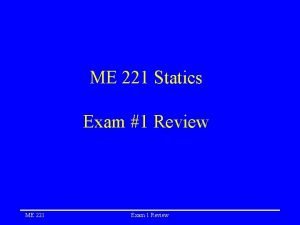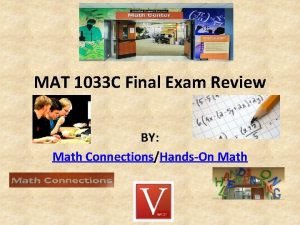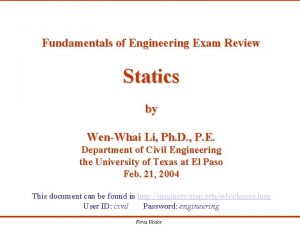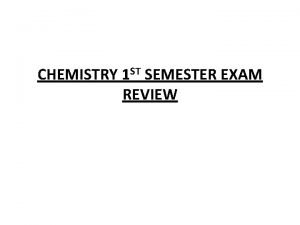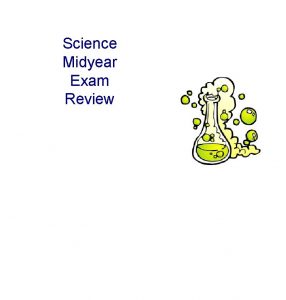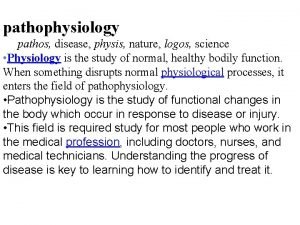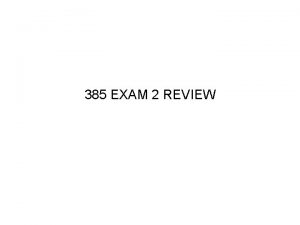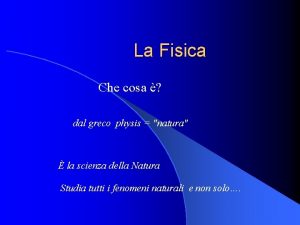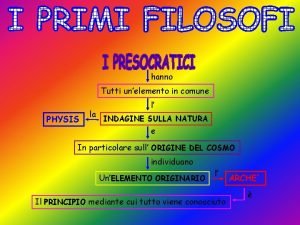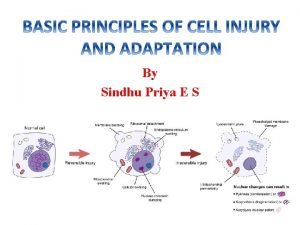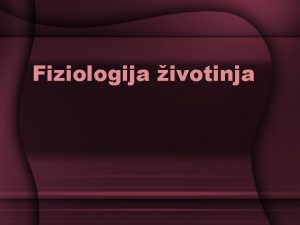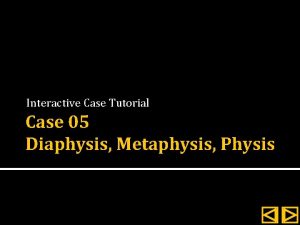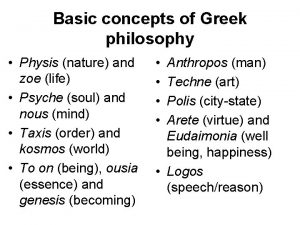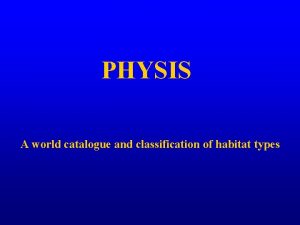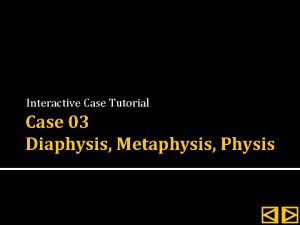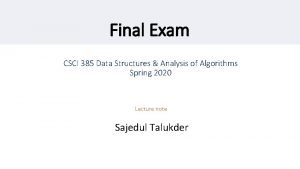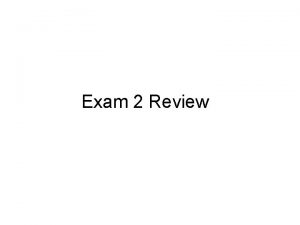385 EXAM 1 REVIEW PRESOKRATIC NATURAL SCIENCE physis





























































- Slides: 61

385 EXAM 1 REVIEW

PRESOKRATIC NATURAL SCIENCE

physis : physiologos :

physis : origin; nature, natural world, physical world, perceptible world; order, arrangement, pattern; appearance; character; disposition; natural form or constitution physiologos : theoretician of physis; natural scientist

5 Assumptions of Ancient Western Science 1. 2. 3. 4. 5.

5 Assumptions of Ancient Western Science 1. Rule-governed, predictable causes (aitia). 2. Aitiai are impersonal "powers" or "properties" (dynamis) of things. 3. Aitiai can be perceptible or imperceptible. 4. Hidden aitiai, although imperceptible, can be rationally inferred. 5. The best epistêmê is reductionist.

Presokratic physiologoi (6 th-5 th cent. BCE) • rejection of traditional (mythic/religious) etiologies • investigation of underlying cause or causes (aitia/aitiai) and single principle (arkhê) operative beneath observable phenomena in nature (physis) • assumption of rational, non-personal causes (aitiai) • adoption of non-personal, “objective” language to formulate and express logos

Material Monism

Material Monism • material substrate. • material and temporal source of existing things. • ungenerated, eternal, and self-consistent. • differences are results of variations of substrate. • existing things are phenomenal and ephemeral • substrate may be apprehensible only by the mind.

Pluralism

Pluralism • plural realities exist • each ungenerated, self-consistent, indivisible, imperishable • phenomena from different combinations of plural realities • existing things are phenomenal and ephemeral • plural realities apprehensible only by the mind

Natural Scientist Thales Anaximander Anaximenes Pythagoras Empedokles Demokritos arkhê process M or P?

Natural Scientist arkhê process M or P? Thales “water” ? ? ? M Anaximander apeiron cycle of “justice” M Anaximenes “air” condensation/rarefaction M Pythagoras number arithmetical M Empedokles 4 elements union/separation P Demokritos “atoms” chance collisions P

HIPPOKRATIC MEDICINE HUMORAL THEORY

ELEMENT earth water air fire HUMOR QUALITIES INSTANCE

ELEMENT HUMOR QUALITIES INSTANCE earth black bile cold and dry (? ) water air fire

ELEMENT HUMOR QUALITIES INSTANCE earth black bile cold and dry (? ) water phlegm cold and wet mucus, saliva air fire

ELEMENT HUMOR QUALITIES INSTANCE earth black bile cold and dry (? ) water phlegm cold and wet mucus, saliva air blood hot and wet blood fire

ELEMENT HUMOR QUALITIES INSTANCE earth black bile cold and dry (? ) water phlegm cold and wet mucus, saliva air blood hot and wet blood fire yellow bile hot and dry bile, vomit

HUMORS

PEPSIS

FOOD STOMACH FECES

CHYLE FOOD STOMACH FECES LIVER

VEINS LIVER (CHYLE) EXCESS BILES URINE

4 HUMORS VEINS LIVER (CHYLE) EXCESS BILES URINE

AIR BLOOD HEART RIGHT LEFT BODY

LUNGS AIR BLOOD PNEUMA ZOTIKON HEART RIGHT LEFT BODY

PNEUMA ZOTIKON NERVES

PNEUMA ZOTIKON BRAIN PNEUMA PSYKHIKON NERVES

HIPPOKRATIC MEDICINE EMBRYOLOGY

Generation of Seed (sperma) tradition panspermia encephalomyeletic theory (a) male sperm female receptacle (b) sex heats blood, produces froth sperm

Generation of Seed (sperma) tradition panspermia encephalomyeletic theory (a) male sperm female receptacle (b) sex heats blood, produces froth sperm (a) sperm derived from all parts of body (b) sperm as microcosmic (c) sperm channeled through brain and spine (d) sperm stored in testicles and uterus

Generation of Seed (sperma) tradition panspermia encephalomyeletic theory (a) male sperm female receptacle (b) sex heats blood, produces froth sperm (a) sperm derived from all parts of body (b) sperm as microcosmic (c) sperm channeled through brain and spine (d) sperm stored in testicles and uterus (a) sperm made in brain and spine, stored in testicles [and uterus? ] (b) sperm made in brain and spine, transferred to testicles during sex ( friction)

Sex Differentiation (1) (2) (3)

Sex Differentiation male/female : hot/cold hot womb male cold womb female/female : right/left male on right side, female on left male/female : strong/weak (a) sperm both male and female (b) both types exist in both parents (c) M + M M; F + F F (d) M + F M or F depending on quantities

Resemblance panspermia

Resemblance sperm drawn from all parts of body retains characteristics of source parts panspermia combinations of male and female sperm favor transfer of characteristics either of stronger or quantitatively greater sperm

Development alimentary pneumatic fetus sucks nourishment directly from amniotic fluid (~ meconium, suckling reflex) pneuma through umbilicus causes coagulation of blood into constituent humors and parts (~ sedimentation) pneuma inflates embryo, forming placental membranes peptic innate heat cooks sperm embryo (~ baking) fetal development male = 30 days / female = 42 days male = 3 months / female = 4 months fetal movement initiates lactation (blood/fat breast milk) deformity shape of uterus contusion to mother

HIPPOKRATIC MEDICINE GYNECOLOGY

Female Body menstruation blood lactation milk childbirth fluids; child afterbirth placenta; fluids low surface integrity

Menstruation fetus in cold uterus female flesh soft, porous, spongy low female emphytos thermôtês compromised pepsis excess blood collects in tissues menstruation of nutriment flesh absorbs fluids

Menstrual Pathology dropsy hysterike pnyx (hysterical suffocation) anadromê (uterine displacement)

Menstrual Pathology excess suppresse d menses ____ deficiency narrowness of uterus; distance between cervix and vaginal opening; obstruction of menses: closure of cervix plethora dropsy sexual activity ----------virginity --------------------- hysterikê pnyx -------------sexual activity _______ _ infrequent intercourse _________ sex moistens vagina and uterus: dryness anadromê ________ _ revulsion therapy (antispasis)

ALEXANDRIAN MEDICINE

Alexandrian Medicine Praxagoras Herophilus Erasistratus

Alexandrian Medicine Praxagoras Herophilus Erasistratus • veins (blood) and arteries (pneuma) • neura = tendons and nerves

Alexandrian Medicine Praxagoras Herophilus Erasistratus • veins (blood) and arteries (pneuma) • neura = tendons and nerves • nerves (pneuma psykhikon), arteries (pneuma zôtikon), veins (blood) • neura traced to spinal cord and cerebellum • description of facial nerves and ventricles • identification of motor and sensory nerves • classification of pulse (sphygmos)

Alexandrian Medicine Praxagoras Herophilus Erasistratus • veins (blood) and arteries (pneuma) • neura = tendons and nerves • nerves (pneuma psykhikon), arteries (pneuma zôtikon), veins (blood) • neura traced to spinal cord and cerebellum • description of facial nerves and ventricles • identification of motor and sensory nerves • classification of pulse (sphygmos) • digestion = mechanical grinding • triplokia : weaving of neura (sensation), arteries (movement), veins (nutrition) • discovery of cardiac valves • dissection of brain; brain as vacuum pump • vacuums account for movement of fluids • extravenous fluid transfer (paremptôsis) disease

HELLENISTIC/ROMAN MEDICINE

Trends in Late Hellenistic Medicine

Trends in Late Hellenistic Medicine • ban on human dissection (autopsia) reinstated • incorporation of Greek world into Roman Empire • increased competition from practitioners, volume and diversity of clients • increased competition among theories of disease and treatment • end of state support for medical research

Roman Medicine • institutionalization of medicine (a) medical corps (triage) (b) legionary hospitals (c) sports medicine (d) urban clinics (valetudinaria) • shift in medical education to cater to specific societal demands • trending towards dietetics, regimens (exercise, bathing), self-help manuals, vade mecum

Medical Sects: Dogmatism (RATIONALISM, HUMORALISM)

Medical Sects: Dogmatism (RATIONALISM, HUMORALISM) • knowledge of hidden causes of disease possible, relevant, necessary • increasing scholasticism (emphasis on theory and prognosis)

Medical Sects: Empiricism

Medical Sects: Empiricism • theoretical knowledge of “hidden causes” of disease impossible, unverifiable, unnecessary • direct experience (empeiria) of success and failure guides treatment • medical practice rests on tripod of observation, collective memory, likeness • rejection of dissection

Medical Sects: Methodism

Medical Sects: Methodism • knowledge of patient qua individual impossible and unnecessary • immediate apprehension of symptoms suffices to diagnose and cure • influence of corpuscular theory: body as histological gland • abnormal movement of corpuscles of various sizes through various sizes of bodily pores disease

Medical Sects: Methodism (a) obstructed pores = constriction (status strictus) acute diseases (b) loose pores = relaxation (status laxus) chronic diseases (c) alternating density = mixed (status mixtus) other conditions

Success of Methodism

Success of Methodism • dominant for 3 centuries • spread via Roman army and administration • practical focus • “ 5 -minute diagnosis” • simple taxonomy of disease linked to simple taxonomy of treatment • short training program for certification • low-cost implementation • suitability to urban and military venues of clinic and battlefield
 Physis definition
Physis definition Nomos e physis antigone
Nomos e physis antigone Words using surgery
Words using surgery Medical termiology
Medical termiology Physis suffix meaning
Physis suffix meaning Fizika s jelentése
Fizika s jelentése Ap gov final review
Ap gov final review Environmental science final exam review
Environmental science final exam review Noah carried a skateboard
Noah carried a skateboard Earth science final exam review
Earth science final exam review Natural vs social science
Natural vs social science Three branches of science
Three branches of science Natural science vs physical science
Natural science vs physical science Natural science and social science similarities
Natural science and social science similarities What's your favourite lesson?
What's your favourite lesson? 16385 cmu
16385 cmu Bentuk bilangan oktal dari bilangan desimal 385
Bentuk bilangan oktal dari bilangan desimal 385 Mgt 385
Mgt 385 Em 385 1 1 2014
Em 385 1 1 2014 Ece385
Ece385 385/40
385/40 Soen 385
Soen 385 Ece 385
Ece 385 Xkcd 385
Xkcd 385 Fort polk dmv
Fort polk dmv Parallax
Parallax Zscore excel
Zscore excel Soen 343
Soen 343 459-393-385
459-393-385 World history spring final exam review answers
World history spring final exam review answers You template
You template Spanish 1 final exam
Spanish 1 final exam Spanish 1 review packet
Spanish 1 review packet Human body systems final exam
Human body systems final exam Poe final exam
Poe final exam Akt content guide
Akt content guide Ied final exam
Ied final exam Hbs final exam practice test
Hbs final exam practice test World history semester exam
World history semester exam Entrepreneurship 1 final exam review
Entrepreneurship 1 final exam review Spanish 2 final exam review packet
Spanish 2 final exam review packet Apes ap exam review
Apes ap exam review World history final exam study guide
World history final exam study guide Us history semester 2 final exam review
Us history semester 2 final exam review English 11 first semester exam
English 11 first semester exam Review for exam pronouns
Review for exam pronouns Physics 20 final exam practice
Physics 20 final exam practice Zoology semester 1 exam review answers
Zoology semester 1 exam review answers Eduqas online exam review
Eduqas online exam review Physics fall semester review answers
Physics fall semester review answers American history final exam
American history final exam English 3 fall semester exam review
English 3 fall semester exam review Sph3u exam review
Sph3u exam review English 3 fall semester exam review
English 3 fall semester exam review Chemistry semester 1 exam review answers
Chemistry semester 1 exam review answers Physics 1 exam 2 review
Physics 1 exam 2 review Physics exam 2 review
Physics exam 2 review Statics exam 1
Statics exam 1 Mat 1033 final exam
Mat 1033 final exam Statics exam 3
Statics exam 3 World history semester 1 final exam study guide answers
World history semester 1 final exam study guide answers Chemistry first semester exam review
Chemistry first semester exam review
